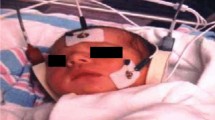Abstract
Auditory evoked responses using BERA were studied in 30 newborn babies with plasma bilirubin ≥15 mgm/dl and repeated after treatment of neonatal jaundice with bilirubin levels of ≤10 mgm/dl. A few jaundiced babies (16.5%) showed absent BERA response at the initial/subsequent examination. After treatment, 3/30 babies showed absent wave form responses and 2 of these were clinically kernicteric.
Jaundiced babies had prolonged wave peak latencies and inter peak latencies. Treated babies showed a tendency towards recovery in their BERA responses which were however not complete. Total plasma bilirubin value at the time of BERA examination and mean maximal bilirubin values had no correlation with the incidence and degree of BERA abnormalities.
Similar content being viewed by others
References
Bhakoo ON, Narang A, Kulkami KN et al. Neonatal morbidity and mortality in hospital born babies.India Pediatr 1975; 12: 443–450.
Maisles MJ. Neonatal jaundice. In: Avery GB, ed.Neonatology: Pathophysiology and Management of the Newborn. 3rd ed. Philadelphia: J.P. Lippincott Co. 1987; p. 551.
Karp WB. Biochemical alterations in neonatal hyperbilirubinemia and bilirubin encephalopathy. A review.Pediatrics 1979; 64: 361–368.
Schreiner RL, Glick MR. Interlaboratory bilirubin variability.Pediatrics 1982; 69: 277–281.
Tay TSH, How PS, Wong HB et al. Value and limitations of bilirubin binding capacity in predicting the development of kernicterus.Aust Paediatr J 1984; 20: 63–66.
Cockington RA. A guide to the use of phototherapy in the management of neonatal hyperbilirubinemia.J Pediatr 1979; 95: 281–285.
Perlman M, Fainmesser P, Sohmer H et al. Auditory nerve-brain stem evoked responses in hyperbilirubinemic neonates.Pediatrics 1983; 72: 658–664.
Nakamura H, Takada S, Shimabuku R et al. Auditory nerve and brain stem responses in new born infants with hyperbilirubinemia.Pediatrics 1985; 75: 703–708.
Vohr BR, Rapisardi G, Karp D et al. The effect of moderate hyperbilirubinemia on auditory brain stem response ABR in term infants.Pediatr Res 1987; 21: 308A (Abstract No. 1239).
Demaquez JL, Deliac PH, Barberot JP et al Auditory evoked brain stem responses in icteric newborns: Alterations after exchange transfusion.Pediatr Res 1987; 22: 227 (Abstract No. 60).
Wennberg RP, Ahlfors CE, Bickers R et al. Abnormal auditory brain stem response in a new born infant with hyperbilirubinemia: improvement with exchange transfusion.J Pediatr 1982; 100: 624–626.
Nwaesei CG, Aerde JV, Boyden M et al. Changes in auditory brainstem responses in hyperbilirubinemic infants before and after change transfusion.Pediatrics 1984; 74: 800–803.
Author information
Authors and Affiliations
Rights and permissions
About this article
Cite this article
Bhandari, V., Narang, A., Mann, S.B.S. et al. Brain stem electric response audiometry in neonates with hyperbilirubinemia. Indian J Pediatr 60, 409–413 (1993). https://doi.org/10.1007/BF02751203
Issue Date:
DOI: https://doi.org/10.1007/BF02751203




